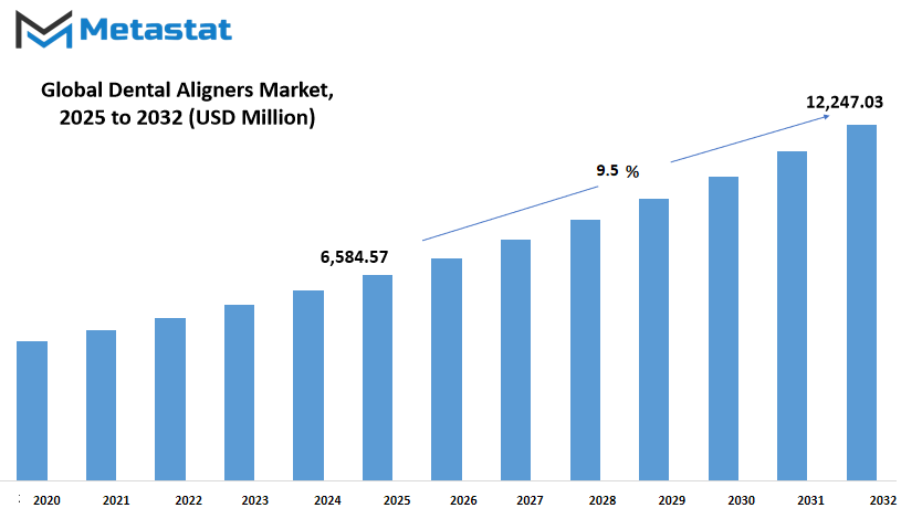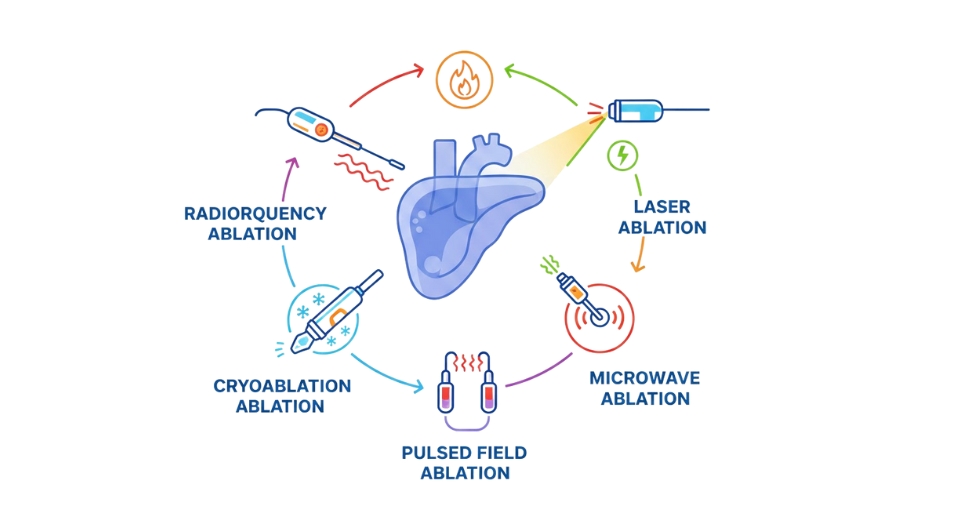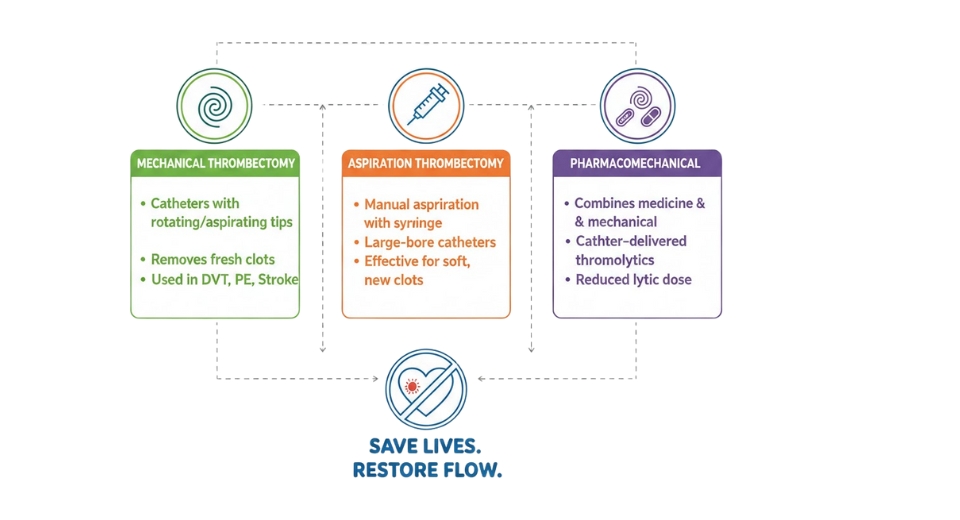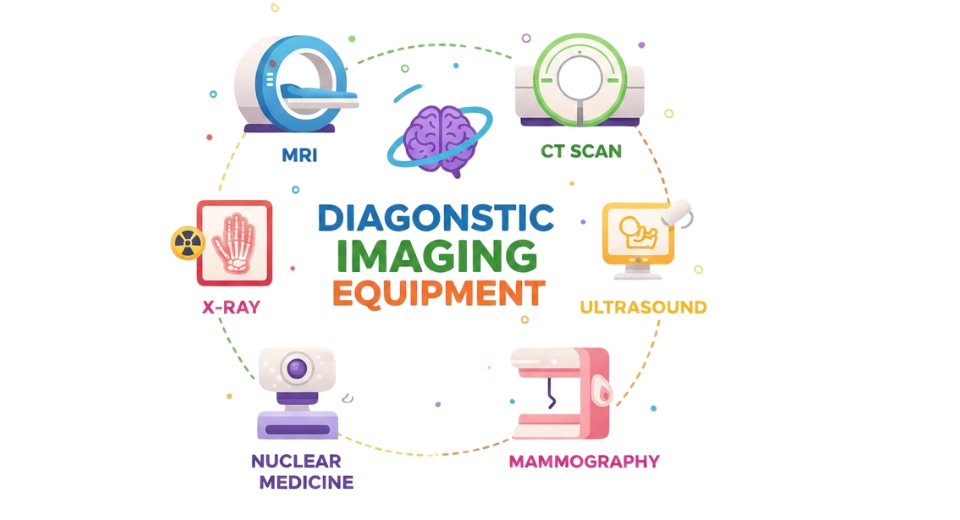MARKET OVERVIEW
The global dental aligners market is bound to change how people consider straightening teeth in the future, merging innovation and comfort into a process that will be both personal and effortless. It will come out of being a technical option into something that becomes akin to a daily wellness decision. Patients will begin to expect treatments that are discreet and customized, with practitioners providing digital scans that are as comfortable as snapping a photo of one's smile. Technologies like clear, custom-fit trays will be sent speedily to homes or offices, ending guesswork about comfort and fit.
Clinicians will adopt novel software programs that enable them to stage outcomes in rich detail, having patients feel like they're creating the design in collaboration instead of merely receiving a solo prescription.
Such applications will enable users to preview their smiles to come in real-life simulations, increasing confidence along the way. Clear aligners will become more straightforward to adjust, made to move teeth more slowly but surely over shorter periods, so clinicians will no longer have to count on lengthy adjustment cycles. The materials will be softer where comfort is essential and tougher where precision is important. Lab procedures will also change. 3D printing will have a bigger part to play, enabling sets of aligners to be made in hours rather than days, all with lower plastic waste.
That will make the clinics more efficient and reduce delays. Patients will not have to make multiple appointments in order to sit through the fundamentals; instead, they will get a full complement of trays all at once, with assistance being offered through simple apps that monitor progress and remind them respectfully when wear time must be attended to. At home, aligners will be synchronized with smart wearables. Ultra-small sensors in the trays will track usage so patients will precisely know how long they've worn them each day, without reminders annoying them. Dentists will receive reminders only when truly necessary, so they can concentrate on complex cases rather than regular check-ins. That will leave clinic time for cases that really require it, so appointments will feel more meaningful rather than routine. Global partnerships will bring high-end aligner solutions to more locations. Smaller town patients will be able to utilize the same equipment that everyone in big cities expects. Delivery times will be reduced as more production becomes decentralized. Clinics will provide scanning and fitting locally, while central labs will produce trays inexpensively. The entire process will seem effortless, as if the solution was developed locally.
Customer support will become more human. Patients will talk with real people who understand both the emotional side of changing one’s smile and the technical side of aligning teeth. That balance will make what may once have felt clinical become reassuring, like having a partner alongside every step of the way.
In the future, talk about straightening teeth will sound less like "medical-speak" and more like selecting a lifestyle enhancement. Wearing trays will be normal, supported, and even pleasant. The process will be hidden, and expectations will be relaxed instead of tense. In that future, selecting a system to correct alignment will feel like selecting a comfortable accessory instead of undergoing a procedure. This change in the way individuals perceive their teeth and how care is given will come naturally, feel comfortable, and human.
Global dental aligners market is estimated to reach $12,247.03 Million by 2032; growing at a CAGR of 9.5% from 2025 to 2032.

GROWTH FACTORS
The global dental aligners market is expected to witness steady growth in the coming years owing to a growing demand for sophisticated orthodontic treatments. There is a growing number of malocclusion and other dental conditions generating a higher demand for clear aligner therapy. With people increasingly demanding aesthetic and minimally invasive orthodontics, dental aligners are being viewed as a more desirable option compared to conventional braces. This change is most evident in younger generations, and among adults looking for discreet ways of enhancing dental alignment without the pain and visual effect of metal brackets. Increased knowledge of oral health, coupled with digital media and social platforms, is also driving the global dental aligners market.
The adoption of advanced materials and enhanced digital scanning technologies will boost treatment accuracy, with quicker and more predictable outcomes. Urban residents, particularly in developed nations, are increasingly demonstrating readiness to embrace aligners, marking a trend toward contemporary, technology-based dental treatment options. Treatment costs are still a major hindrance, restricting middle-income segments who lack suitable insurance cover or funding for such treatments. In most developing and rural areas, lack of awareness of aligner technology and limited access to specialized orthodontic treatment will hamper penetration of the market. Educational campaigns and outreach programs at the community level will be crucial in overcoming these challenges in the future. Increased co-operation between dental professionals and industry might facilitate training and outreach to enable underserved communities to gain a better appreciation of the advantages of aligner treatment.
Technological changes will further transform the global dental aligners market in the future. The growth of tele dentistry and expansion of direct-to-consumer aligner services will open up new possibilities for patients and providers alike.
At-home impression kits and remote consultations are making orthodontic treatment more accessible and convenient, especially for patients in rural or underserved locations. These innovations, along with cheaper subscription-based models, will increase market penetration and stimulate adoption in various economic layers. Future projections indicate closer combination of artificial intelligence and 3D printing technologies in treatment planning and production. This will enhance personalization and efficiency, providing faster and more comfortable options to patients. With the market developing further, strategic collaborations, innovative pricing models, and increased consumer awareness will remain crucial in maintaining long-term growth and greater global acceptance of dental aligners.
MARKET SEGMENTATION
By Product
The global dental aligners market presents a forward-looking picture that is shaped by product types like Braces and Clear Aligners. Projection shows that Braces continue to serve traditional needs, offering visible structure and reliable adjustment methods. Clear Aligners offer a sleek alternative, more discreet and often preferred by individuals seeking subtlety. Expect Clear Aligners to grow significantly, driven by improving technology, better affordability, and increasing interest in aesthetic solutions.
Looking toward the future, innovative materials and smart capabilities will transform treatment options. Braces may integrate sensors or modest electronics to monitor progress automatically. Clear Aligners likely will incorporate computer-aided design and 3D printing to produce custom fits faster and at lower cost. That shift will make customization nearly instantaneous and accessible. Patient-centered care will benefit from remote monitoring tools that track alignment progress through mobile apps. Professional oversight will still guide treatment decisions, but ease of access will increase significantly.
Manufacturers likely will embrace sustainable materials, reducing environmental impact. Clear Aligners may come in recyclable plastics or biodegradable compounds. Braces may get coatings that require fewer emergency visits or adjustments, improving patient convenience. Digital platforms will connect providers and patients more directly, making appointments, scans, and adjustments seamless. Virtual consultations will reduce clinic visits, while still preserving quality through accurate imaging.
Globally, growth in emerging regions will play a key role. Markets in areas with rising incomes will see faster uptake of Clear Aligners, thanks to newfound access to modern treatment. Expansion of training and distribution networks will support that growth. Public-private partnerships could enable wider access to aligner treatments in school-based dentistry programs or community clinics, making orthodontic care more equitable.
Forecasts suggest that Clear Aligners will capture increasing share of the global dental aligners market over time. Braces may retain a solid base among those who prefer simple, proven systems. Overall, combined offerings will grow as awareness of oral health and aesthetic options spreads. Advancements, cost reduction, and smarter delivery platforms will drive the evolution. What emerges will be a global dental aligners market that is more adaptive, accessible, and technology-enhanced, offering efficient care for a broader population.
By Material
The global dental aligners market is expected to experience strong growth in the coming years as demand for effective and discreet orthodontic solutions continues to rise. Increased awareness of dental health, combined with advancements in technology, is driving more people toward clear aligners as an alternative to traditional braces. The market is also benefiting from growing accessibility to dental care, with clinics and online platforms making aligner treatments easier to obtain in both developed and developing regions. These factors are creating opportunities for significant innovation and expansion in the sector.
By material, the global dental aligners market is divided into metal, polyurethane plastic, polyethylene terephthalate glycol (PETG), acrylic resin, and others. Metal, while strong and durable, is less common for clear aligners and is mainly used in specific cases requiring extra structural support. Polyurethane plastic is becoming a preferred choice due to its flexibility, comfort, and resistance to staining, making it ideal for patients seeking a seamless appearance during treatment. Polyethylene terephthalate glycol, or PETG, is widely used because of its transparency and ease of customization, allowing for precise fittings that improve patient satisfaction. Acrylic resin, though less commonly used today, still holds relevance in certain applications where rigidity and low cost are priorities. The “others” category includes emerging materials that are in development to enhance strength, durability, and overall treatment effectiveness.
Technological advancements such as 3D printing and artificial intelligence are expected to influence the global dental aligners market in the near future. These innovations will allow for faster production, better customization, and more predictable treatment outcomes. Digital scanning technologies are also reducing the need for traditional molds, streamlining the process for both patients and providers. This level of efficiency and accuracy is expected to strengthen trust in aligner treatments, contributing to wider adoption worldwide.
Growth will also be supported by increasing investments in research and development, as companies focus on creating materials that balance comfort, durability, and affordability. Expanding consumer preference for non-invasive and discreet dental solutions will continue to push manufacturers to enhance product quality while keeping costs competitive. Furthermore, rising disposable income in developing countries will allow a larger share of the population to access aligner treatments, expanding the customer base and driving market performance.
Overall, the global dental aligners market is on track for sustained growth, driven by material innovation, technological progress, and a growing demand for convenient orthodontic care. This trend points to a future where aligner treatments will become more efficient, more affordable, and more widely available, shaping a modern standard in dental correction.
By Age Group
Growth will shape the global dental aligners market through changing needs of Adults, Teenagers, Children. Technological advances will drive more precise, comfortable options. In the near future, next-generation materials will make aligners thinner, stronger, and smarter. Sensors embedded in these tools will track progress, giving real-time feedback to dentists and wearers. Planning software will become more intuitive, offering virtual previews of outcomes. These previews will build confidence and improve adherence to treatment plans.
Adoption among Adults will rise as remote monitoring becomes standard. Busy schedules will no longer pose a barrier when progress can be reviewed digitally. Convenience will attract working professionals who prefer to skip frequent clinic visits. Advanced tracking will alert to delays or adjustments, reducing complications. Customization will expand, offering aligners that match skin tone, lifestyle habits, and dietary patterns. Design choices will reflect personal style while maintaining function.
Teenagers will benefit from aligners that adjust as facial structures change during growth phases. Growth-adaptive aligners will respond to natural development, guiding teeth movement in harmony with facial evolution. Fun designs, such as temporary color-changing overlays or biometric charms, will transform the experience into something engaging. Social confidence will increase, since orthodontic care will feel less clinical and more expressive.
Children will gain access to early interventions powered by predictive modeling. AI-driven systems will forecast future misalignment and recommend aligners before issues become more severe. Pediatric care will become proactive. Early adoption will prevent more complex treatments later. Soothing textures and gentle pressure will make aligners more comfortable for young jaws. Virtual mascots will guide use, making treatment feel like a playful journey rather than a chore.
Across age groups, digital platforms will unify treatment experiences. A single app will offer progress tracking, appointment scheduling, virtual check-ins, and educational content. Cloud-based records will allow seamless coordination between families, local clinics, and specialist providers. Treatment plans will evolve dynamically as data flows in, optimizing outcomes and reducing treatment time.
The future will enhance access to care in underserved areas. Mobile clinics equipped with 3D scanners and printers will deliver same-day aligners. Tele-orthodontic consultations will bridge geographic gaps. global dental aligners market will expand into regions that once lacked access, creating healthier smiles worldwide.
By End-user
Rapid shifts in technology make the global dental aligners market appear poised for remarkable growth. Predictions about tomorrow’s possibilities suggest that alignment devices will become smarter, more accessible, and deeply integrated into daily life. Anticipated advances hint at digital scans guiding manufacturing with pinpoint accuracy and materials adapting to body temperature to deliver steady pressure exactly where needed. Expectations include such aligners offering progress tracking through connected apps, alerting users when adjustment is needed, and reminding wear schedule, all blending convenience with personalization.
Mentions of by-end-user structure reveal clear segments. By End-user the global dental aligners market is divided as General Dentists, Orthodontists, Others. General Dentists may serve patients with mild misalignment needs, using aligner systems for quick corrections during routine visits. Orthodontists will continue handling complex treatments, but adoption of digital workflows could allow treatments to finish faster and with fewer adjustments, easing patient burden. The Others segment, including cosmetic clinics, corporate wellness programs, and direct-to-consumer platforms, may drive outreach into nontraditional settings. Clinics might offer quick scans during wellness events, enabling patients to begin treatment journeys immediately. Corporate wellness programs may include teeth alignment as part of benefits portfolios, especially with emphasis on appearance and self-care growing stronger. Direct-to-consumer models might offer at-home scanning, design consultations online, and overnight shipping of aligners to simplify access.
Looking ahead, demand patterns suggest that affordability will rise as manufacturing scales up and automation reduces costs. For consumers, price points once considered steep may become routine, making straightening teeth more inclusive. Distribution systems may shift too, with online platforms backed by local labs offering faster turnaround and improved oversight. Delivery windows might shrink from weeks to days. As data collection grows through connected devices, predictive treatment paths could emerge, forecasting progress and adjusting designs before small issues appear, reducing mid-treatment pauses.
Investment flows will likely tilt toward companies blending orthodontic expertise with digital innovation. Start-ups combining machine learning, 3D printing, and user-friendly interfaces may attract more funding. Established clinics may partner with tech developers to stay current. The global dental aligners market seems ready to transform patient experiences by making straight-teeth care smarter, more affordable, and more widely available.
|
Forecast Period |
2025-2032 |
|
Market Size in 2025 |
$6,584.57 million |
|
Market Size by 2032 |
$12,247.03 Million |
|
Growth Rate from 2025 to 2032 |
9.5% |
|
Base Year |
2024 |
|
Regions Covered |
North America, Europe, Asia-Pacific Green, South America, Middle East & Africa |
REGIONAL ANALYSIS
The global dental aligners market is experiencing rapid growth, driven by increasing awareness of oral health and the rising demand for effective teeth alignment solutions. Technological advancements and the availability of innovative aligner products are transforming how dental care is approached worldwide. In the coming years, the market will witness further expansion as more regions invest in advanced dental technologies and affordable treatment options become more accessible to diverse populations.
Based on geography, the global dental aligners market is segmented into North America, Europe, Asia-Pacific, South America, and the Middle East & Africa. North America, including the U.S., Canada, and Mexico, continues to hold a significant share due to high consumer awareness, advanced healthcare infrastructure, and strong adoption of modern dental procedures. Europe, with countries such as the UK, Germany, France, Italy, and the Rest of Europe, is seeing consistent growth fueled by a rise in cosmetic dentistry and supportive insurance policies that make aligner treatments more affordable.
The Asia-Pacific region, consisting of India, China, Japan, South Korea, and the Rest of Asia-Pacific, is expected to see the fastest growth in the near future. Increasing urbanization, rising disposable incomes, and a growing emphasis on personal appearance are major factors influencing this surge. As dental care becomes more advanced and accessible in these countries, the adoption of aligner treatments will continue to expand. South America, including Brazil, Argentina, and the Rest of South America, is also gaining momentum as awareness campaigns and digital dental technologies reach a wider audience.
In the Middle East & Africa, with regions such as GCC Countries, Egypt, South Africa, and the Rest of Middle East & Africa, steady growth is expected as healthcare facilities advance and the demand for innovative orthodontic solutions rises. Economic development and a younger population with increasing aesthetic preferences will further support this trend.
Looking toward the future, the global dental aligners market will evolve with the integration of artificial intelligence, 3D printing, and digital scanning technologies, offering more customized and efficient treatments. Greater collaboration between dental professionals and technology providers will enhance the patient experience, making treatments faster and more precise. Increased investments in research and development will lead to the creation of aligners that are more comfortable, durable, and cost-effective, broadening accessibility across different income groups.
As awareness grows and technology continues to advance, the global dental aligners market will not only expand geographically but also adapt to meet the unique demands of each region, shaping a more efficient and inclusive future for dental care worldwide.

COMPETITIVE PLAYERS
The global dental aligners market looks full of exciting possibilities. Thought today concentrates on clear aligner treatment that uses gradual movement of teeth, future progress will center on personalized solutions powered by advanced scanning, 3D printing, and artificial intelligence. Consistent improvements in patient experience will shape how care unfolds. Greater customization will emerge where treatment paths adapt in real time based on scanning feedback and tooth movement tracking. Significant acceleration in treatment speed will appear through new materials offering optimal flexibility with gentle force application, so comfort will enhance and overall duration of treatment will drop.
Major leaders active across this space already will push innovation forward. Align Technology, Inc. will refine scanning devices to be faster, more precise, and easier to use in clinical settings. Envista (Ormco Corporation) and Institut Straumann AG will expand research into material science that supports improved transparency and strength. Dentsply Sirona will explore partnerships to integrate digital workflows from scan to manufacturing. 3M Corporation will explore novel adhesives that work seamlessly with aligners for better retention during daily use. Argen Corporation and Henry Schein, Inc. will streamline supply chains so turn-around times shrink and clinician access increases. OraPharma will investigate oral health additives that may support gum health during aligner therapy. TP Orthodontics, Inc. will focus on ergonomic design improvements for both patient comfort and ease of clinician handling.
Newer names such as Candid Care Co., Byte, Smilers, Angel Aligner, Smile White Holdings Limited, Smile2Impress, Sunshine Smiles Orthodonti will continue to push direct-to-consumer options and fast home-based services. Expect cloud-based treatment monitoring tools that give feedback almost instantly. Future view shows clinics and remote providers coordinating through shared platforms analyzing movement data and alerting when adjustments will be needed.
Growth story for the global dental aligners market will follow adoption of smarter designs and seamless digital connections. Wider access to affordable treatment will expand as costs fall and tele-orthodontic options multiply. Overall effect will be more individuals choosing clear aligner solutions, motivated by comfort, speed, and invisibility. Future-driven innovation will ensure that daily life will integrate dental care more naturally, with aligners that adjust proactively and fit seamlessly into routines. Progress in treatment personalization and efficiency will keep momentum strong for years ahead.
Dental Aligners Market Key Segments:
By Product
- Braces
- Clear Aligners
By Material
- Metal
- Polyurethane Plastic
- Polyethylene Terephthalate Glycol
- Acrylic Resin
- Others
By Age Group
- Adults
- Teenagers
- Children
By End-user
- General Dentists
- Orthodontists
- Others
Key Global Dental Aligners Industry Players
- Align Technology, Inc.
- Envista (Ormco Corporation)
- Institut Straumann AG
- Dentsply Sirona
- 3M Corporation
- Argen Corporation
- Henry Schein, Inc.
- OraPharma
- TP Orthodontics, Inc.
- Candid Care Co.
- Byte
- Smilers
- Angel Aligner
- Smile White Holdings Limited
- Smile2Impress
WHAT REPORT PROVIDES
- Full in-depth analysis of the parent Industry
- Important changes in market and its dynamics
- Segmentation details of the market
- Former, on-going, and projected market analysis in terms of volume and value
- Assessment of niche industry developments
- Market share analysis
- Key strategies of major players
- Emerging segments and regional growth potential








 US: +1 3023308252
US: +1 3023308252






